Picking up from yesterday.
library(ggplot2)
# mydata <- read.csv("binary.csv")
str(mydata)
#> 'data.frame': 400 obs. of 4 variables:
#> $ admit: int 0 1 1 1 0 1 1 0 1 0 ...
#> $ gre : int 380 660 800 640 520 760 560 400 540 700 ...
#> $ gpa : num 3.61 3.67 4 3.19 2.93 3 2.98 3.08 3.39 3.92 ...
#> $ rank : int 3 3 1 4 4 2 1 2 3 2 ...
mydata$rank <- factor(mydata$rank)
mylogit <- glm(admit ~ gre + gpa + rank, data = mydata, family = "binomial")
summary(mylogit)
#>
#> Call:
#> glm(formula = admit ~ gre + gpa + rank, family = "binomial",
#> data = mydata)
#>
#> Deviance Residuals:
#> Min 1Q Median 3Q Max
#> -1.6268 -0.8662 -0.6388 1.1490 2.0790
#>
#> Coefficients:
#> Estimate Std. Error z value Pr(>|z|)
#> (Intercept) -3.989979 1.139951 -3.500 0.000465 ***
#> gre 0.002264 0.001094 2.070 0.038465 *
#> gpa 0.804038 0.331819 2.423 0.015388 *
#> rank2 -0.675443 0.316490 -2.134 0.032829 *
#> rank3 -1.340204 0.345306 -3.881 0.000104 ***
#> rank4 -1.551464 0.417832 -3.713 0.000205 ***
#> ---
#> Signif. codes: 0 '***' 0.001 '**' 0.01 '*' 0.05 '.' 0.1 ' ' 1
#>
#> (Dispersion parameter for binomial family taken to be 1)
#>
#> Null deviance: 499.98 on 399 degrees of freedom
#> Residual deviance: 458.52 on 394 degrees of freedom
#> AIC: 470.52
#>
#> Number of Fisher Scoring iterations: 4
We're going to graph GPA on the x axis let's generate some points
range(mydata$gpa) # using GPA for your staff size
#> [1] 2.26 4.00
gpa_sequence <- seq(from = 2.25, to = 4.01, by = .01) # 177 points along x axis
This is in the IDRE example but they made it complicated. Step one build a data frame that has our sequence of GPA points, the mean of GRE for every entry in that column, and our 4 factors repeated 177 times.
constantGRE <- with(mydata, data.frame(gre = mean(gre), # keep GRE constant
gpa = rep(gpa_sequence, each = 4), # once per factor level
rank = factor(rep(1:4, times = 177)))) # there's 177
str(constantGRE)
#> 'data.frame': 708 obs. of 3 variables:
#> $ gre : num 588 588 588 588 588 ...
#> $ gpa : num 2.25 2.25 2.25 2.25 2.26 2.26 2.26 2.26 2.27 2.27 ...
#> $ rank: Factor w/ 4 levels "1","2","3","4": 1 2 3 4 1 2 3 4 1 2 ...
Make predictions for every one of the 177 GPA values * 4 factor levels. Put that prediction in a new column called theprediction
constantGRE$theprediction <- predict(object = mylogit,
newdata = constantGRE,
type = "response")
Plot one line per level of rank, color the lines uniquely. NB the lines are not straight, nor perfectly parallel nor equally spaced.
ggplot(constantGRE, aes(x = gpa, y = theprediction, color = rank)) +
geom_smooth()
#> `geom_smooth()` using method = 'loess' and formula 'y ~ x'

You might be tempted to just average the lines. Don't. If you want to know GPA by GRE not including Rank build a new model because (0.6357521 + 0.4704174 + 0.3136242 + 0.2700262) / 4 is not the proper answer.
Let's do it.
# leave rank out call it new name
mylogit2 <- glm(admit ~ gre + gpa, data = mydata, family = "binomial")
summary(mylogit2)
#>
#> Call:
#> glm(formula = admit ~ gre + gpa, family = "binomial", data = mydata)
#>
#> Deviance Residuals:
#> Min 1Q Median 3Q Max
#> -1.2730 -0.8988 -0.7206 1.3013 2.0620
#>
#> Coefficients:
#> Estimate Std. Error z value Pr(>|z|)
#> (Intercept) -4.949378 1.075093 -4.604 4.15e-06 ***
#> gre 0.002691 0.001057 2.544 0.0109 *
#> gpa 0.754687 0.319586 2.361 0.0182 *
#> ---
#> Signif. codes: 0 '***' 0.001 '**' 0.01 '*' 0.05 '.' 0.1 ' ' 1
#>
#> (Dispersion parameter for binomial family taken to be 1)
#>
#> Null deviance: 499.98 on 399 degrees of freedom
#> Residual deviance: 480.34 on 397 degrees of freedom
#> AIC: 486.34
#>
#> Number of Fisher Scoring iterations: 4
Repeat the rest of the process to get one line
constantGRE2 <- with(mydata, data.frame(gre = mean(gre),
gpa = gpa_sequence))
constantGRE2$theprediction <- predict(object = mylogit2,
newdata = constantGRE2,
type = "response")
ggplot(constantGRE2, aes(x = gpa, y = theprediction)) +
geom_smooth()
#> `geom_smooth()` using method = 'loess' and formula 'y ~ x'



